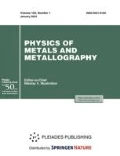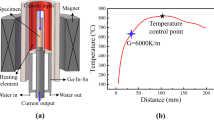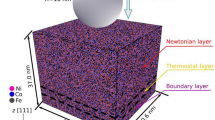Abstract
In the dynamic theory of martensitic transformations, temperature Ms of the start of transformation corresponds to conditions that are optimal for generating waves by nonequilibrium d electrons that control the growth of a martensitic crystal. The recognition of relative damping \({{\Gamma}}_{{\text{e}}}^{'}\) of s electrons plays a substantial role in this case. A general analysis that has made it possible to propose, for the first time, an analytical formula for critical size Dc\(\left( {{{\Gamma}}_{{\text{e}}}^{'}} \right)\) of austenite grains is used to interpret the results for chromium–nickel steels, in which the transformation is initiated by strong magnetic fields. Under conditions of positive bulk magnetostriction, a magnetic field with intensity H lowers the chemical potential of electrons. As a result, the Dc(\({{\Gamma}}_{{\text{e}}}^{'},\) H) value decreases and austenite with a grain diameter of D, which was stabilized by condition D < Dc(\({{\Gamma}}_{{\text{e}}}^{'},\) 0) in the absence of a field, becomes destabilized, since inequality D > Dc(\({{\Gamma}}_{{\text{e}}}^{'},\)H) is fulfilled. The dynamic theory predicts a sharp increase in the Dc(\({{\Gamma}}_{{\text{e}}}^{'},\) 0) value at \({{\Gamma}}_{{\text{e}}}^{'}\) → 1. This is evidenced by value Dc\(\left( {{{\Gamma}}_{{\text{e}}}^{'}} \right)\) ≥ 1 mm for steel 67Kh2N22, which is three orders of magnitude larger than Dc(\({{\Gamma}}_{{\text{e}}}^{'},\) 0) ≈ 1 μm for the Fe–31Ni alloy. Other peculiarities of the effect of magnetic field on the martensitic transformation are also discussed.





Similar content being viewed by others
REFERENCES
M. P. Kashchenko, Wave Model of Martensite Growth at γ–α Transformation in Iron-Based Alloys, 2nd ed. (Regulyarnaya i Khaoticheskaya Dinamika, Moscow, 2010) [in Russian].
M. P. Kashchenko and V. G. Chashchina, “Dynamic model of supersonic martensitic crystal growth,” Phys.-Usp. 54, 331–349 (2011).
M. P. Kashchenko and V. G. Chashchina, A Dynamic Model of the Formation of Twin Martensitic Crystals at γ–α Transformations in Iron-Based Alloys (Regulyarnaya i Khaoticheskaya Dinamika, Moscow, 2010) [in Russian].
M. P. Kashchenko and V. G. Chashchina, “Critical grain size in the γ → α martensite transformation. Thermodynamic analysis with regard to spatial scales characteristic of martensite nucleation,” Phys. Mesomech. 13, 189–194 (2010).
M. P. Kashchenko and V. G. Chashchina, “Grain size dependence of the γ → α martensite transformation starting temperature,” Phys. Mesomech. 13, 195–202 (2010).
A. A. Leont’ev, Candidate’s Dissertation in Physics-Mathematics (Sverdlovsk, 1985).
L. N. Romashov, A. A. Leont’ev, and V. D. Sadovskii, “Martensitic transformation in chromium-nickel steel in magnetic field at the temperatures below 77 K,” Fiz. Met. Metalloved. 66, 935–942 (1988).
I. V. Zolotarevskii, S. V. Loskutova, V. L. Snezhnoi, and L. M. Sheiko, “Magnetostriction of the paraprocess of austenitic alloys near the martensite point,” Fiz. Met. Metalloved. 47, 1312–1313 (1979).
E. Scheil, “Über die Umwandlung des Austenit in geharten Stahle,” Z. Anorg. Chem. 180, 1–6 (1929).
M. G. Gaidukov and V. D. Sadovskii, “Effect of austenite grain size on martensitic transformation in steel,” Dokl. Akad. Nauk SSSR 96, 67–69 (1954).
M. Umemoto and W. S. Owen, “Effects of austenitizing temperature and aaustenite grain size on the formation of athermal martensite in an iron-nickel and an iron-nickel-carbon alloy,” Metall. Trans. 5, 2041–2046 (1974).
Yu. F. Ivanov, M. P. Kashchenko, A. B. Markov, and V. P. Rotshtein, “The critical grain size for the nucleation of α-martensite,” Zh. Tekh. Fiz. 65, 99–102 (1995).
E. N. Blinova, A. M. Glezer, N. B. D’yakonova, and V. A. Zhorin, “Size effect during martensitic transformation in iron-nickel alloys quenched from the melt,” Izv. Ross. Akad. Nauk, Ser. Fiz. 65, 1444–1449 (2001).
M. P. Kashchenko, N. M. Kashchenko, A. V. Korolev, S. A. Oglezneva, and V. G. Chashchina, “Critical grain size estimation in the γ–α martensitic transformation with athermal macrokinetics by the example of Fe–Ni–Cr system,” Phys. Mesomech. 22, 203–208 (2019).
M. P. Kashchenko and V. G. Chashchina, “Dynamic interpretation of formation of parallel thin-plate martensite crystals in strong magnetic fields,” Met. Sci. Heat Treat. 56, 343–346 (2014).
K. P. Belov, “Ferromagnets and antiferromagnets near the Curie point,” Usp. Fiz. Nauk 65, 207–256 (1958).
V. M. Schastlivtsev, Yu. V. Kaletina, and E. A. Fokina, Martensitic Transformation in Magnetic Field (Ural Branch, Russian Academy of Sciences, 2007) [in Russian].
E. A. Fokina, L. V. Smirnov, V. N. Olesov, V. M. Schastlivtsev, Yu. V. Kaletina, and A. Yu. Kaletin, “Influence of austenite grain size on the features of martensitic transformation during cooling and magnetic treatment of Fe–Ni–C alloys,” Fiz. Met. Metalloved. 81, 103–111 (1996).
M. P. Kashchenko, “Interpretation of a number of specific morphological features of martensite of the Fe–Ni and Fe–C systems in the phonon maser model,” Fiz. Met. Metalloved. 58, 862–869 (1984).
A. A. Leont’ev, V. M. Schastlivtsev, and L. N. Romashov, “Habit and orientation of martensite crystals formed in a magnetic field,” Fiz. Met. Metalloved. 58, 950–957 (1984).
I. V. Zolotarevskii, S. V. Loskutova, and M. O. Shchetinina, “Influence of the magnetic state of austenite on the martensitic transformation in Fe–Ni alloys,” Fiz. Met. Metalloved. 119, 794 –801 (2018).
Funding
The authors acknowlledge support from the Ministry of Science and Higher Education of Russia via the state assignment no. 075-00243-20-01 of 08/26/2020 within the framework of the FEUG-2020-0013 theme Environmental Aspects of Rational Nature Management.
Author information
Authors and Affiliations
Corresponding author
Additional information
Translated by O. Kadkin
Rights and permissions
About this article
Cite this article
Kashchenko, M.P., Kashchenko, N.M. & Chashchina, V.G. Dynamic Theory of the Effect of a Strong Magnetic Field on the Martensitic Transformation in Steels with Austenite Grain Sizes Close to a Critical Value. Phys. Metals Metallogr. 122, 47–53 (2021). https://doi.org/10.1134/S0031918X21010051
Received:
Revised:
Accepted:
Published:
Issue Date:
DOI: https://doi.org/10.1134/S0031918X21010051




